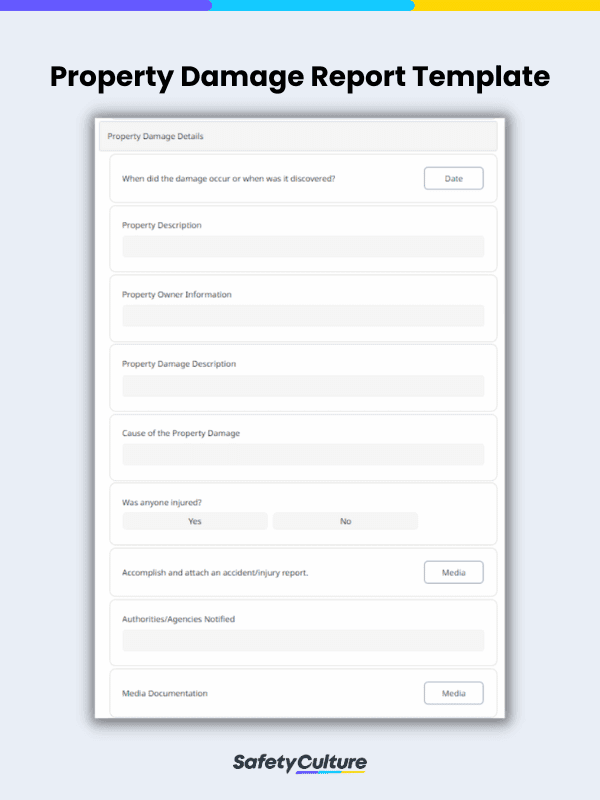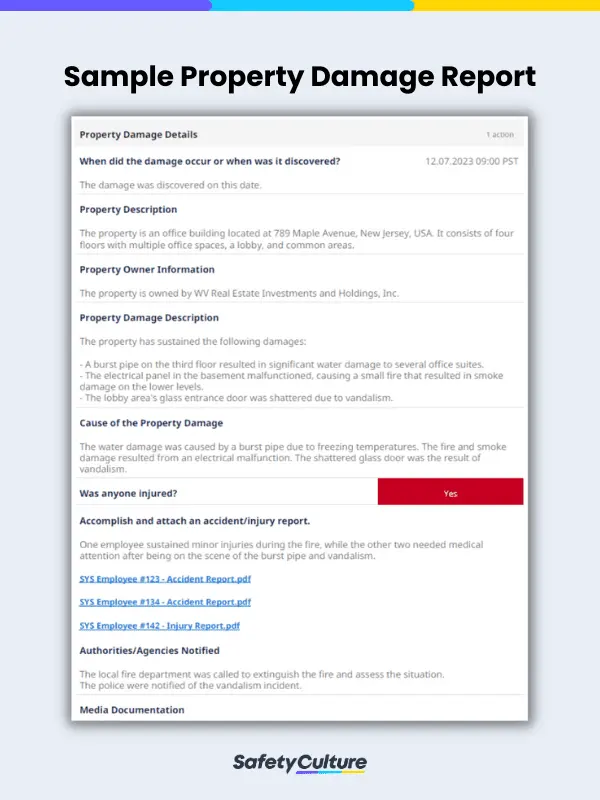What is a Property Damage Report?
A property damage report is a formal document that provides a detailed account of the damage sustained by a property. It serves as a comprehensive record of the incident, describing the extent of the damage, the cause or event that led to it, and any other pertinent information related to the incident.
They are essential for assessing the severity of the damage, determining liability, and facilitating the process of repairs, insurance claims, or legal actions.
What is Classified as Property Damage?
Property damage refers to any harm, destruction, or loss incurred by physical assets or property of an organization. It includes damage caused by various factors, such as the following:
- Accidental Damage – vehicle crashes or collisions, falls, fires, water leaks
- Natural Disasters – earthquakes, floods, hurricanes, tornadoes, wildfires
- Vandalism – graffiti, broken windows, property destruction
- Theft or Burglary – broken locks, damaged doors, stolen belongings
- Fire Damage – structural damage, burnt belongings, smoke damage
- Water Damage – structural deterioration, mold growth, damaged possessions
- Storm Damage – high winds, hail, fallen trees, damage from flying debris
- Environmental Factors – resulting from environmental factors
- Equipment Failure – caused by equipment malfunctions or failures
- Wear and Tear – leading to structural issues or functional problems
Why Create a Report for Property Damage
As part of property management, noting damages and even early signs of potential damages is crucial to help prevent them from occurring or happening again.
Aside from that, creating a report for property damage is essential for the following reasons:
- Documentation – serves as an official and comprehensive document that records the details of the damage and an accurate account of the incident
- Insurance Claims – provides evidence of the damage, helps determine the value of the claim, and assists in establishing the cause of the damage
- Assessing Liability – helps determine liability for the damage
- Repairs and Restoration – provides a detailed understanding of the damage sustained
- Historical Reference – acts as a historical reference, capturing the property’s condition before and after an incident
- Communication and Transparency – facilitates clear and transparent communication between all parties involved
What Should be Included in a Property Damage Report?
To ensure the accuracy and completeness of your report, it’s helpful to use a property damage report form with organized sections and fields. This way, you can document every key detail, including the following:
- Date and Time of the Damage
- Reporter’s Contact Information
- Property and Property Owner Information
- Description of Damage
- Cause of Damage
- Injury/Accident Report
- Visual Documentation/Evidence
- Witness Information
- Insurance Details
- Repair Costs/Estimates
- Other Relevant Documents (e.g., Police or Incident Report)
How Do You Write a Property Damage Report?
To guide you in writing a property damage report, it’s best to use a report form template. Carefully account for every important detail by following these steps:
- Include your full name, address, phone number, and email address as the one reporting the property damage. This allows the recipient (e.g., insurance company or law enforcement agency) to quickly contact you for further communication.
- Specify the date and time when the damage occurred or was discovered.
- Describe the property, including its address, relevant identifiers (such as apartment number or unit), and any additional details that help identify its location.
- Provide a clear and detailed description of the damage, including the affected areas, the extent of the damage, and any visible signs of destruction.
- Explain what caused the damage, whether it was a specific incident (e.g., fire, flood, vandalism) or a gradual occurrence (e.g., water leakage, structural issues). If the cause is unknown, state that it is under investigation.
- Attach photos or any other visual documentation that captures the damage.
- If applicable:
- include the names, contact information, and a summary of observations or statements of witnesses; and
- provide the details of your insurance policy that will be used during your insurance claim processing.
- Obtain repair estimates from qualified professionals experienced in addressing the specific type of damage.
- Attach relevant supporting files (e.g., police reports, incident reports, invoices for temporary repairs, or correspondence with appropriate parties) to provide further context or evidence to support your claim.
- Sign the report to confirm its authenticity and completeness.
Here’s a look at an accomplished sample report using a damage report form.
Remember to keep a copy of the property damage report for your records and provide the original to the appropriate recipient, such as your insurance company, property manager, or legal advisor, depending on the circumstances.
FAQs About Property Damage Reports
It’s highly recommended to create and file property damage reports as soon as possible after the damage has occurred. These should be submitted to the insurance company or relevant authorities, depending on the nature of the incident. This way, prompt investigation and actions can be taken to address the damage.
Some cases, such as accidents, vandalism, or incidents involving criminal activity, may require the involvement of the authorities. To understand such conditions, contact your law enforcement agency to report the incident and obtain an official report to support your property damage claim.
While it’s not necessary to include them in the report, it can be helpful to attach any repair costs, estimates, or invoices as supporting documents. Including this information provides a clearer understanding of the financial impact of the property damage.




